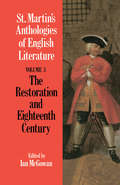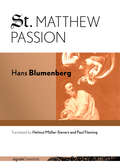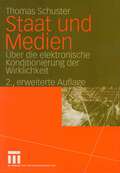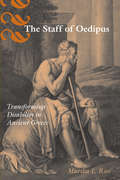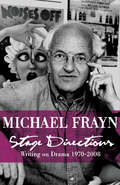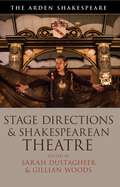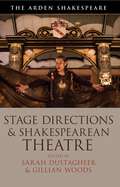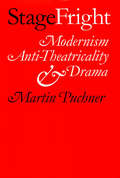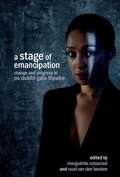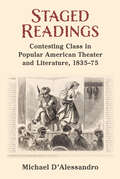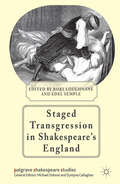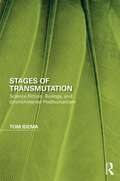- Table View
- List View
St. Martin's Anthologies of English Literature: Volume 3, Restoration and Eighteenth Century (1160-1798) (Anthologies of English Literature)
by Palgrave Macmillan LtdThe selection of writing in this anthology brings alive the excitement, wit, and exuberance of the Restoration and eighteenth century.
St. Matthew Passion (signale|TRANSFER: German Thought in Translation)
by Hans BlumenbergSt. Matthew Passion is Hans Blumenberg's sustained and devastating meditation on Jesus's anguished cry on the cross, "My God, my God, why have you forsaken me?" Why did this abandonment happen, what does it mean within the logic of the Gospels, how have believers and nonbelievers understood it, and how does it live on in art? With rare philological acuity and vast historical learning, Blumenberg unfolds context upon context in which this cry has reverberated, from early Christian apologetics and heretics to twentieth-century literature and philosophy. Blumenberg's guide through this unending story of divine abandonment is Johann Sebastian Bach's monumental Matthäuspassion, the parabolic mirror that bundled eighteen hundred years of reflection on the fate of the crucified and the only available medium that allows us post-Christian listeners to feel the anguish of those who witnessed the events of the Passion. With interspersed references to writers such as Goethe, Rilke, Kafka, Freud, and Benjamin, Blumenberg gathers evidence to raise the singular question that, in his view, Christian theology has not been able to answer: How can an omnipotent God be so offended by his creatures that he must sacrifice and abandon his own Son?
St Paul's Cathedral Precinct in Early Modern Literature and Culture: Spatial Practices (Early Modern Literary Geographies)
by Roze HentschellPrior to the 1666 fire of London, St Paul's Cathedral was an important central site for religious, commercial, and social life in London. The literature of the period - both fictional and historical - reveals a great interest in the space, and show it to be complex and contested, with multiple functions and uses beyond its status as a church. St Paul's Cathedral Precinct in Early Modern Literature and Culture: Spatial Practices animates the cathedral space by focusing on the every day functions of the building, deepening and sometimes complicating previous works on St Paul's. St Paul's Cathedral Precinct in Early Modern Literature and Culture is a study of London's cathedral, its immediate surroundings, and its everyday users in early modern literary and historical documents and images, with special emphasis on the late sixteenth and early seventeenth centuries. It discusses representations of several of the seemingly discrete spaces of the precinct to reveal how these spaces overlap with and inform one another spatially, and argues that specific locations should be seen as mutually constitutive and in a dynamic and ever-evolving state. The varied uses of the precinct, including the embodied spatial practices of early modern Londoners and visitors, are examined, including the walkers in the nave, sermon-goers, those who shopped for books, the residents of the precinct, the choristers, and those who were devoted to church repairs and renovations.
St Paul's Cathedral Precinct in Early Modern Literature and Culture: Spatial Practices (Early Modern Literary Geographies)
by Roze HentschellPrior to the 1666 fire of London, St Paul's Cathedral was an important central site for religious, commercial, and social life in London. The literature of the period - both fictional and historical - reveals a great interest in the space, and show it to be complex and contested, with multiple functions and uses beyond its status as a church. St Paul's Cathedral Precinct in Early Modern Literature and Culture: Spatial Practices animates the cathedral space by focusing on the every day functions of the building, deepening and sometimes complicating previous works on St Paul's. St Paul's Cathedral Precinct in Early Modern Literature and Culture is a study of London's cathedral, its immediate surroundings, and its everyday users in early modern literary and historical documents and images, with special emphasis on the late sixteenth and early seventeenth centuries. It discusses representations of several of the seemingly discrete spaces of the precinct to reveal how these spaces overlap with and inform one another spatially, and argues that specific locations should be seen as mutually constitutive and in a dynamic and ever-evolving state. The varied uses of the precinct, including the embodied spatial practices of early modern Londoners and visitors, are examined, including the walkers in the nave, sermon-goers, those who shopped for books, the residents of the precinct, the choristers, and those who were devoted to church repairs and renovations.
Staat und Medien: Über die elektronische Konditionierung der Wirklichkeit
by Thomas SchusterIn Anbetracht der ständigen Ausweitung des Einflussbereichs der Massenmedien muss man sich die Frage stellen, ob das enorme Informationsangebot tatsächlich zur Herausbildung eines vielfältigen Meinungsspektrums führt oder ob die Nachrichten-Schwemme nicht vielmehr eine meinungsverflachende und betäubende Wirkung hat. Fest steht zumindest, dass die Möglichkeiten einer intendierten Wirklichkeitsverfälschung mit den modernen elektronischen Medien eine völlig neue Qualität erfahren haben.
Staatliche Initiativen zur Förderung der Informationsgesellschaft: Multimedia-Pilotprojekte in Deutschland und den USA in ihrem politischen Kontext
by Andreas Breiter Bernd Beckert Martin Hagen Herbert KubicekDie Autoren untersuchen die Regierungsprogramme der 1990er Jahre zur Förderung der Informationsgesellschaft in Deutschland und den USA für die Anwendungsbereiche Bildung, Verwaltung und Fernsehen. Dabei identifizieren sie sowohl Unterschiede als auch Gemeinsamkeiten in den Ländern und Bereichen. Der Rückblick ermöglicht interessante Schlüsse in Hinsicht auf die Zukunftsperspektiven von multimedialen Anwendungen in der Schule, E-Government oder web-basiertem interaktivem Fernsehen.
Stabilität öffentlicher Meinung: Wie der Charakter einer Streitfrage den Einfluss der Medien begrenzt
by Dominik J. LeinerDieses Buch zeigt, dass die öffentliche Meinung vor allem bei solchen politischen Streitfragen ins Wanken gerät, die im Alltag der Bürger kaum eine Rolle spielen und bei denen Herz und Verstand uneins sind: etwa Militäreinsätze und finanzpolitische Entscheidungen. Anhand einer quantitativen empirischen Studie wird untersucht, inwieweit dieser Befund auf psychologischen Prozessen fußt – und inwieweit die individuelle Einstellungsstärke mit dem Auf und Ab der öffentlichen Meinung zusammenhängt. Eine einjährige Panel-Studie, die statische Auswertung historischer Umfragedaten und eine Analyse der Medienberichterstattung erlauben einen tiefen Einblick in die Dynamik der öffentlichen Meinung.
The Stability of Laughter: The Problem of Joy in Modernist Literature (Routledge Studies in Twentieth-Century Literature)
by James NikopoulosA "sad and corrupt" age, a period of "crisis" and "upheaval"—what T.S. Eliot famously summed up as "the panorama of futility and anarchy which is contemporary history." Modernism has always been characterized by its self-conscious sense of suffering. Why, then, was it so obsessed with laughter? From Baudelaire, Nietzsche, Bergson and Freud to Pirandello, Beckett, Hughes, Barnes, and Joyce, no moment in cultural history has written about laughter this much. James Nikopoulos investigates modernity’s paradoxical relationship with mirth. Why was the gesture we conventionally associate with happiness deemed the only sensible way of responding to a world, as Max Weber wrote, that had been "disenchanted of its gods?" In answering these questions, Nikopoulos also delves into our ongoing relationship with laughter. He looks to contemporary research in emotion and evolutionary theory, as well as to the two-thousand-plus-year history of the philosophy of humor, in order to propose a novel way of understanding laughter, humor, and their complicated relationships with modern life. The Stability of Laughter explores how art unsettles the simplifications we revert to in our attempts to make sense of human history and social interaction.
The Stability of Laughter: The Problem of Joy in Modernist Literature (Routledge Studies in Twentieth-Century Literature)
by James NikopoulosA "sad and corrupt" age, a period of "crisis" and "upheaval"—what T.S. Eliot famously summed up as "the panorama of futility and anarchy which is contemporary history." Modernism has always been characterized by its self-conscious sense of suffering. Why, then, was it so obsessed with laughter? From Baudelaire, Nietzsche, Bergson and Freud to Pirandello, Beckett, Hughes, Barnes, and Joyce, no moment in cultural history has written about laughter this much. James Nikopoulos investigates modernity’s paradoxical relationship with mirth. Why was the gesture we conventionally associate with happiness deemed the only sensible way of responding to a world, as Max Weber wrote, that had been "disenchanted of its gods?" In answering these questions, Nikopoulos also delves into our ongoing relationship with laughter. He looks to contemporary research in emotion and evolutionary theory, as well as to the two-thousand-plus-year history of the philosophy of humor, in order to propose a novel way of understanding laughter, humor, and their complicated relationships with modern life. The Stability of Laughter explores how art unsettles the simplifications we revert to in our attempts to make sense of human history and social interaction.
Stadt und Straße: Anfangsorte in der amerikanischen Literatur (Lettre)
by Sascha PöhlmannStadt und Straße - wie und warum werden gerade diese Orte oft zu außergewöhnlichen literarischen Anfangsorten gemacht? Sascha Pöhlmann wendet sich in doppelter Absicht an ein Publikum, das sich für US-amerikanische Literatur (etwa von Walt Whitman, Don DeLillo, Jack Kerouac oder Kathy Acker) interessiert, aber nicht den akademischen Fachdiskurs verfolgt. Erstens will er dieser Leserschaft ein Konzept nahebringen, das zentral für die amerikanische Kulturgeschichte ist: nämlich die Idee des Anfangs. Zweitens will er dadurch eine neue Perspektive auf bekannte Klassiker der amerikanischen Prosa eröffnen und zugleich weniger bekannte, aber nicht minder bedeutsame Texte erschließen.
Städtebilder zwischen Literatur und Journalismus: Wien, Berlin und das Feuilleton der Weimarer Republik (Literaturwissenschaft / Kulturwissenschaft)
by Christian Jäger Erhard SchützStadttexte und Selbstbilder der Prager Moderne: Literarische Identitätsdiskurse im urbanen Raum (Interkulturalität. Studien zu Sprache, Literatur und Gesellschaft #20)
by Ulrike Mascher»Aber war man als Prager Tscheche, Deutscher oder Jude?«, fragt der Philosoph Vilém Flusser in seinen Erinnerungen. Im mehrsprachigen, plurikulturellen Prag der Moderne sind Stadterfahrung und Identitätsdiskurse untrennbar miteinander verflochten. Wie wird die Stadt in deutsch- und tschechischsprachigen Texten aus der ersten Hälfte des 20. Jahrhunderts modelliert und zu individuellen wie kollektiven Identitätsentwürfen ins Verhältnis gesetzt? Ulrike Mascher legt eine umfangreiche komparatistische Abhandlung zu dieser Thematik vor, indem sie deutsch- und tschechischsprachige Pragtexte der Zeit parallel liest und damit eingefahrene Forschungsmeinungen revidieren kann.
The Staff of Oedipus: Transforming Disability in Ancient Greece (Corporealities: Discourses Of Disability)
by Martha L. RoseAncient Greek images of disability permeate the Western consciousness: Homer, Teiresias, and Oedipus immediately come to mind. But The Staff of Oedipus looks at disability in the ancient world through the lens of disability studies, and reveals that our interpretations of disability in the ancient world are often skewed. These false assumptions in turn lend weight to modern-day discriminatory attitudes toward disability. Martha L. Rose considers a range of disabilities and the narratives surrounding them. She examines not only ancient literature, but also papyrus, skeletal material, inscriptions, sculpture, and painting, and draws upon modern work, including autobiographies of people with disabilities, medical research, and theoretical work in disability studies. Her study uncovers the realities of daily life for people with disabilities in ancient Greece and challenges the translation of the term adunatos (unable) as "disabled," with all its modern associations.
Stage Directions: Writing on Theatre 1970-2008
by Michael FraynStage Directions covers half a lifetime and the whole range of Frayn's theatrical writing, right up to a new piece about his latest play, Afterlife. It is also a reflection on his path into theatre: the 'doubtful beginnings' of his childhood, his subsequent scorn as a young man and, surprisingly late in life, his reluctant conversion. Whatever subjects he tackles, from the exploration of the atomic nucleus to the mechanics of farce, Michael Frayn is never less than fascinating, delightfully funny and charming. This book encapsulates a lifetime's work and is guaranteed to be a firm favourite with his legions of fans around the world.
Stage Directions and Shakespearean Theatre
by Gillian Woods Sarah DustagheerWhat do 'stage directions' do in early modern drama? Who or what are they directing: action on the stage, or imagination via the page? Is the label 'stage direction' helpful or misleading? Do these 'directions' provide evidence of Renaissance playhouse practice? What happens when we put them at the centre of literary close readings of early modern plays? Stage Directions and Shakespearean Theatre investigates these problems through innovative research by a range of international experts. This collection of essays examines the creative possibilities of stage directions and and their implications for actors and audiences, readers and editors, historians and contemporary critics. Looking at the different ways stage directions make meaning, this volume provides new insights into a range of Renaissance plays.
Stage Directions and Shakespearean Theatre
by Gillian Woods Sarah DustagheerWhat do 'stage directions' do in early modern drama? Who or what are they directing: action on the stage, or imagination via the page? Is the label 'stage direction' helpful or misleading? Do these 'directions' provide evidence of Renaissance playhouse practice? What happens when we put them at the centre of literary close readings of early modern plays? Stage Directions and Shakespearean Theatre investigates these problems through innovative research by a range of international experts. This collection of essays examines the creative possibilities of stage directions and and their implications for actors and audiences, readers and editors, historians and contemporary critics. Looking at the different ways stage directions make meaning, this volume provides new insights into a range of Renaissance plays.
Stage Fright: Modernism, Anti-Theatricality, and Drama
by Martin PuchnerGrounded equally in discussions of theater history, literary genre, and theory, Martin Puchner's Stage Fright: Modernism, Anti-Theatricality, and Drama explores the conflict between avant-garde theater and modernism. While the avant-garde celebrated all things theatrical, a dominant strain of modernism tended to define itself against the theater, valuing lyric poetry and the novel instead. Defenders of the theater dismiss modernism's aversion to the stage and its mimicking actors as one more form of the old "anti-theatrical" prejudice. But Puchner shows that modernism's ambivalence about the theater was shared even by playwrights and directors and thus was a productive force responsible for some of the greatest achievements in dramatic literature and theater.A reaction to the aggressive theatricality of Wagner and his followers, the modernist backlash against the theater led to the peculiar genre of the closet drama—a theatrical piece intended to be read rather than staged—whose long-overlooked significance Puchner traces from the theatrical texts of Mallarmé and Stein to the dramatic "Circe" chapter of Joyce's Ulysses. At times, then, the anti-theatrical impulse leads to a withdrawal from the theater. At other times, however, it returns to the stage, when Yeats blends lyric poetry with Japanese Nôh dancers, when Brecht controls the stage with novelistic techniques, and when Beckett buries his actors in barrels and behind obsessive stage directions. The modernist theater thus owes much to the closet drama whose literary strategies it blends with a new mise en scène. While offering an alternative history of modernist theater and literature, Puchner also provides a new account of the contradictory forces within modernism.
The Stage Life of Props (Theater: Theory/Text/Performance)
by Andrew SoferIn The Stage Life of Props, Andrew Sofer aims to restore to certain props the performance dimensions that literary critics are trained not to see, then to show that these props are not just accessories, but time machines of the theater. Using case studies that explore the Eucharistic wafer on the medieval stage, the bloody handkerchief on the Elizabethan stage, the skull on the Jacobean stage, the fan on the Restoration and early eighteenth-century stage, and the gun on the modern stage, Andrew Sofer reveals how stage props repeatedly thwart dramatic convention and reinvigorate theatrical practice. While the focus is on specific objects, Sofer also gives us a sweeping history of half a millennium of stage history as seen through the device of the prop, revealing that as material ghosts, stage props are a way for playwrights to animate stage action, question theatrical practice, and revitalize dramatic form. Andrew Sofer is Assistant Professor of English, Boston College. He was previously a stage director.
A Stage of Emancipation: Change and Progress at the Dublin Gate Theatre
An Open Access edition of this book is available on the Liverpool University Press website and the OAPEN library. As the prominence of the recent #WakingTheFeminists movement illustrates, the Irish theatre world is highly conscious of the ways in which theatre can foster social emancipation. This volume of essays uncovers a wide range of marginalised histories by reflecting on the emancipatory role that the Dublin Gate Theatre (est. 1928) has played in Irish culture and society, both historically and in more recent times. The Gate’s founders, Hilton Edwards and Michéal mac Liammóir, promoted the work of many female playwrights and created an explicitly cosmopolitan stage on which repressive ideas about gender, sexuality, class and language were questioned. During Selina Cartmell’s current tenure as director, cultural diversity and social emancipation have also featured prominently on the Gate’s agenda, with various productions exploring issues of ethnicity in contemporary Ireland. The Gate thus offers a unique model for studying the ways in which cosmopolitan theatres, as cultural institutions, give expression to and engage with the complexities of identity and diversity in changing, globalised societies. CONTRIBUTORS: David Clare, Marguérite Corporaal, Mark Fitzgerald, Barry Houlihan, Radvan Markus, Deirdre McFeely, Justine Nakase, Siobhan O'Gorman, Mary Trotter, Grace Vroomen, Ian R. Walsh, Feargal Whelan
Staged Normality in Shakespeare's England (Palgrave Shakespeare Studies)
by Rory Loughnane Edel SempleThis book looks at the staging and performance of normality in early modern drama. Analysing conventions and rules, habitual practices, common things and objects, and mundane sights and experiences, this volume foregrounds a staged normality that has been heretofore unseen, ignored, or taken for granted. It draws together leading and emerging scholars of early modern theatre and culture to debate the meaning of normality in an early modern context and to discuss how it might transfer to the stage. In doing so, these original critical essays unsettle and challenge scholarly assumptions about how normality is represented in the performance space. The volume, which responds to studies of the everyday and the material turn in cultural history, as well as to broader philosophical engagements with the idea of normality and its opposites, brings to light the essential role that normality plays in the composition and performance of early modern drama.
Staged Readings: Contesting Class in Popular American Theater and Literature, 1835-75
by Michael D'AlessandroStaged Readings studies the social consequences of 19th-century America’s two most prevalent leisure forms: theater and popular literature. In the midst of watershed historical developments—including numerous waves of immigration, two financial Panics, increasing wealth disparities, and the Civil War—American theater and literature were developing at unprecedented rates. Playhouses became crowded with new spectators, best-selling novels flew off the shelves, and, all the while, distinct social classes began to emerge. While the middle and upper classes were espousing conservative literary tastes and attending family matinees and operas, laborers were reading dime novels and watching downtown spectacle melodramas like Nymphs of the Red Sea and The Pirate’s Signal or, The Bridge of Death!!! As audiences traveled from the reading parlor to the playhouse (and back again), they accumulated a vital sense of social place in the new nation. In other words, culture made class in 19th-century America. Based in the historical archive, Staged Readings presents a panoramic display of mid-century leisure and entertainment. It examines best-selling novels, such as Harriet Beecher Stowe’s Uncle Tom’s Cabin and George Lippard’s The Quaker City. But it also analyzes a series of sensational melodramas, parlor theatricals, doomsday speeches, tableaux vivant displays, curiosity museum exhibits, and fake volcano explosions. These oft-overlooked spectacles capitalized on consumers’ previous cultural encounters and directed their social identifications. The book will be particularly appealing to those interested in histories of popular theater, literature and reading, social class, and mass culture.
Staged Transgression in Shakespeare's England (Palgrave Shakespeare Studies)
by Rory Loughnane Edel SempleStaged Transgression in Shakespeare's England is a groundbreaking collection of seventeen essays, drawing together leading and emerging scholars to discuss and challenge critical assumptions about the transgressive nature of the early modern English stage. These essays shed new light on issues of gender, race, sexuality, law and politics.
Stages of Loss: The English Comedians and their Reception
by George Oppitz-TrotmanStages of Loss supplies an original and deeply researched account of travel and festivity in early modern Europe, complicating, revising, and sometimes entirely rewriting received accounts of the emergence and development of professional theatre. It offers a history of English actors travelling and performing abroad in early modern Europe, and Germany in particular, during the sixteenth and seventeenth centuries. These players, known as English Comedians, were among the first professional actors to perform in central and northern European courts and cities. The vital contributions made by them to the development of a European theatre institution have long been neglected owing to the pre-eminence of national theatre histories and the difficulty of researching an inherently evanescent phenomenon across large distances. These contributions are here introduced in their proper contexts for the first time. Stages of Loss explores connections real and perceived between diminishments of national value and the material wealth transported by itinerant players; representations of loss, waste, and profligacy within the drama they performed; and the extent to which theatrical practice and the process of canonization have led to archival and interpretive losses in theatre history. Situating the English Comedians in a variety of economic, social, religious, and political contexts, it explores trends and continuities in the reception of their itinerant theatre, showing how their incorporation into modern theatre history has been shaped by derogatory assessments of travelling theatre and itinerant people in the seventeenth and eighteenth centuries. Stages of Loss reveals that the Western theatre institution took shape partly as a means of accommodating, controlling, evaluating, and concealing the work of migrant strangers.
Stages of Loss: The English Comedians and their Reception
by George Oppitz-TrotmanStages of Loss supplies an original and deeply researched account of travel and festivity in early modern Europe, complicating, revising, and sometimes entirely rewriting received accounts of the emergence and development of professional theatre. It offers a history of English actors travelling and performing abroad in early modern Europe, and Germany in particular, during the sixteenth and seventeenth centuries. These players, known as English Comedians, were among the first professional actors to perform in central and northern European courts and cities. The vital contributions made by them to the development of a European theatre institution have long been neglected owing to the pre-eminence of national theatre histories and the difficulty of researching an inherently evanescent phenomenon across large distances. These contributions are here introduced in their proper contexts for the first time. Stages of Loss explores connections real and perceived between diminishments of national value and the material wealth transported by itinerant players; representations of loss, waste, and profligacy within the drama they performed; and the extent to which theatrical practice and the process of canonization have led to archival and interpretive losses in theatre history. Situating the English Comedians in a variety of economic, social, religious, and political contexts, it explores trends and continuities in the reception of their itinerant theatre, showing how their incorporation into modern theatre history has been shaped by derogatory assessments of travelling theatre and itinerant people in the seventeenth and eighteenth centuries. Stages of Loss reveals that the Western theatre institution took shape partly as a means of accommodating, controlling, evaluating, and concealing the work of migrant strangers.
Stages of Transmutation: Science Fiction, Biology, and Environmental Posthumanism (Perspectives on the Non-Human in Literature and Culture)
by Tom IdemaStages of Transmutation: Science Fiction, Biology, and Environmental Posthumanism develops the theoretical perspective of environmental posthumanism through analyses of acclaimed science fiction novels by Greg Bear, Octavia Butler, Kim Stanley Robinson, and Jeff VanderMeer, in which the human species suddenly transforms in response to new or changing environments. Narrating dramatic ecological events of human-to-nonhuman encounter, invasion, and transmutation, these novels allow the reader to understand the planet as an unstable stage for evolution and the human body as a home for bacteria and viruses. Idema argues that by drawing tension from biological theories of interaction and emergence (e.g. symbiogenesis, epigenetics), these works unsettle conventional relations among characters, technologies, story-worlds, and emplotment, refiguring the psychosocial work of the novel as always already biophysical. Problematizing a desire to compartmentalize and control life as the property of human subjects, these novels imagine life as an environmentally mediated, staged event that enlists human and nonhuman actors. Idema demonstrates how literary narratives of transmutation render biological lessons of environmental instability and ecological interdependence both meaningful and urgent—a vital task in a time of mass extinction, hyperpollution, and climate change. This volume is an important intervention for scholars of the environmental humanities, posthumanism, literature and science, and science and technology studies.
